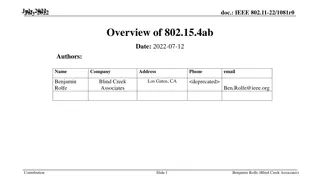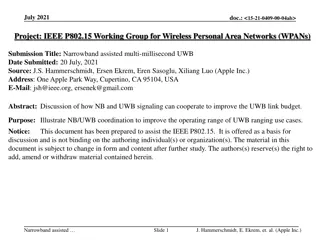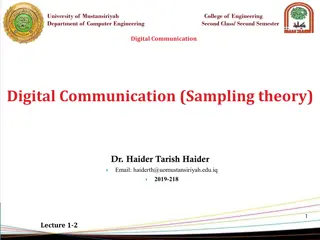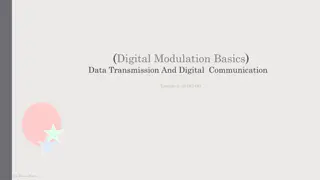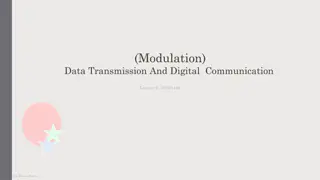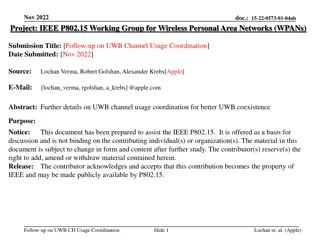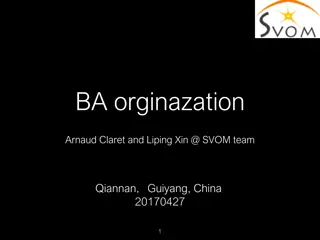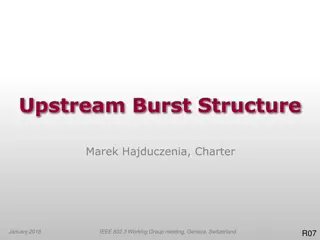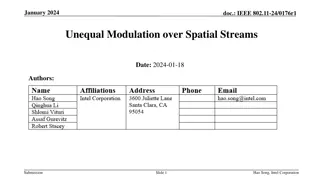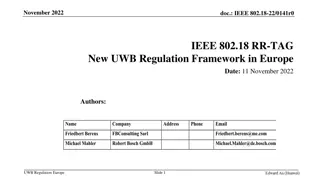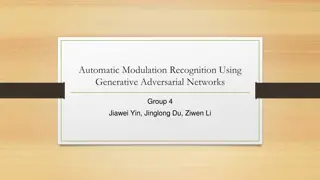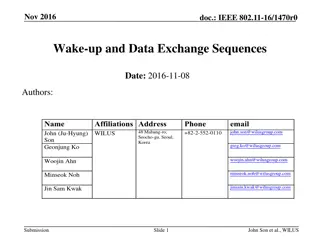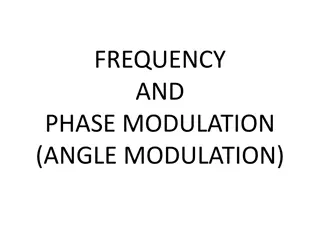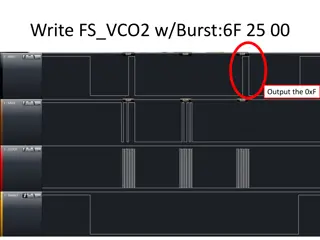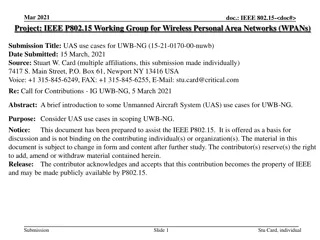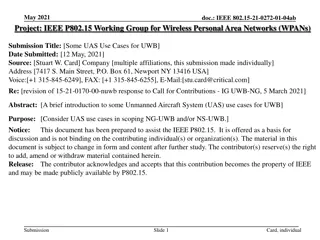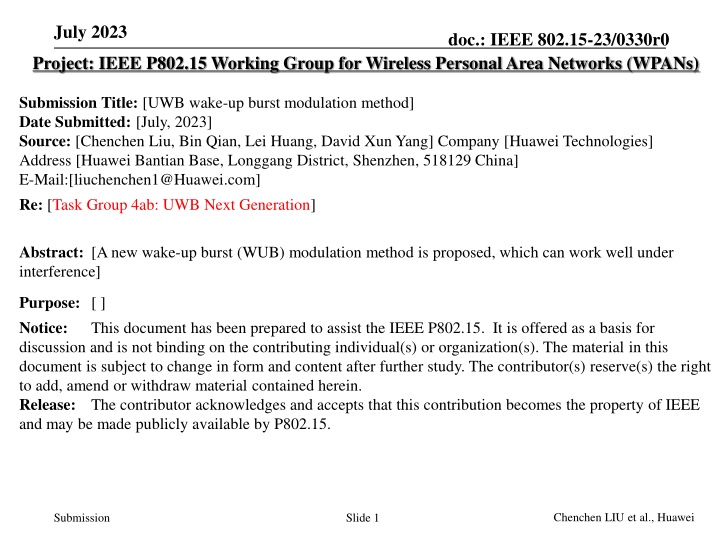
UWB Wake-Up Burst Modulation Method for Wireless Personal Area Networks
Discover a novel wake-up burst modulation method designed to function effectively amidst interference in Wireless Personal Area Networks. The method proposes a unique approach to modulating wake-up bursts for improved performance in UWB communication systems.
Download Presentation

Please find below an Image/Link to download the presentation.
The content on the website is provided AS IS for your information and personal use only. It may not be sold, licensed, or shared on other websites without obtaining consent from the author. If you encounter any issues during the download, it is possible that the publisher has removed the file from their server.
You are allowed to download the files provided on this website for personal or commercial use, subject to the condition that they are used lawfully. All files are the property of their respective owners.
The content on the website is provided AS IS for your information and personal use only. It may not be sold, licensed, or shared on other websites without obtaining consent from the author.
E N D
Presentation Transcript
July 2023 doc.: IEEE 802.15-23/0330r0 Project: IEEE P802.15 Working Group for Wireless Personal Area Networks (WPANs) Submission Title: [UWB wake-up burst modulation method] Date Submitted: [July, 2023] Source: [Chenchen Liu, Bin Qian, Lei Huang, David Xun Yang] Company [Huawei Technologies] Address [Huawei Bantian Base, Longgang District, Shenzhen, 518129 China] E-Mail:[liuchenchen1@Huawei.com] Re: [Task Group 4ab: UWB Next Generation] Abstract: [A new wake-up burst (WUB) modulation method is proposed, which can work well under interference] Purpose: [ ] Notice: discussion and is not binding on the contributing individual(s) or organization(s). The material in this document is subject to change in form and content after further study. The contributor(s) reserve(s) the right to add, amend or withdraw material contained herein. Release: The contributor acknowledges and accepts that this contribution becomes the property of IEEE and may be made publicly available by P802.15. This document has been prepared to assist the IEEE P802.15. It is offered as a basis for Chenchen LIU et al., Huawei Submission Slide 1
July 2023 doc.: IEEE 802.15-23/0330r0 Background The wake-up message is based on millisecond spaced bursts of BPSK modulated UWB pulses at the 62.4 MHz PRF of the HRP UWB PHY, with each wakeup burst (WUB) consisting of 500 chips 5%), which is approximately 8.0 s in duration. Each WUB signals one bit using OOK where presence of the WUB is a binary 1 and absence of the WUB is a binary 0 5% pulses (i.e., 4000 Time 1ms Chenchen LIU et al., Huawei Submission Slide 2
July 2023 doc.: IEEE 802.15-23/0330r0 Background Since the WUB is at the PRF of 62.4 MHz with unknown sequence, any UWB signal at the mean PRF of 62.4*k MHz will be misinterpreted as WUB. The transmission of binary 0 is susceptible to the interference Chenchen LIU et al., Huawei Submission Slide 3
July 2023 doc.: IEEE 802.15-23/0330r0 Background The demodulation of WUB requires calculation of detector threshold based on SYNC signal The balance of 0 1 and 1 0 error probability will have a great impact on the decoding performance Chenchen LIU et al., Huawei Submission Slide 4
July 2023 doc.: IEEE 802.15-23/0330r0 Proposed WUB modulation method Each WUB contains two candidate time intervals for the BPSK modulated UWB pulses The BPSK modulated UWB pulses are transmitted only in one of the two interval based on the coded wake-up ID bit to send Time Time 4us 4us 4us 4us 1ms 1ms Binary 1 Binary 0 Chenchen LIU et al., Huawei Submission Slide 5
July 2023 doc.: IEEE 802.15-23/0330r0 Propose WUB demodulation method The receiver demodulate the WUB by comparing the accumulated energy during two candidate time intervals E1 E0 Time 4us 4us 1ms Demodulation metric as follows, where E0 and E1 are the corresponding accumulated energy of the two intervals E0<E1 0 E0>E1 1 Chenchen LIU et al., Huawei Submission Slide 6
July 2023 doc.: IEEE 802.15-23/0330r0 Simulations The demodulation threshold is set to ? the power of WUB and ?? is the power of AWGN noise OSR=4, m-sequence of length 511 and 255, Butterworth pulse, 1 M bits tested for each SNR ?+ ??, where E is Chenchen LIU et al., Huawei Submission Slide 7
July 2023 doc.: IEEE 802.15-23/0330r0 Simulations The interference power is 6dB or 9dB less with respect to the signal through the whole WUB Chenchen LIU et al., Huawei Submission Slide 8
July 2023 doc.: IEEE 802.15-23/0330r0 Advantages of the proposed modulation Works well under interference (the abs value of E0 and E1 may both increase, but the relative relationship may keep still) No need to estimate detector threshold No bias in bit errors since 0 1 and 1 0 error probability are equal Avoid long periods of all zero waveform Chenchen LIU et al., Huawei Submission Slide 9
July 2023 doc.: IEEE 802.15-23/0330r0 References [1] 15-22-0654-00-04ab-draft-text-for-uwb-wake-up-radio [2] 15-21-0557-01-04ab-uwb-wake-up-signaling [3] 15-22-0282-01-04ab-the-advantages-of-uwb-wakeup [4] P802.15.4z, Draft Standard for Low-Rate Wireless Networks Chenchen LIU et al., Huawei Submission Slide 10
July 2023 doc.: IEEE 802.15-23/0330r0 Appendix Chenchen LIU et al., Huawei Submission Slide 11
July 2023 doc.: IEEE 802.15-23/0330r0 Appendix Chenchen LIU et al., Huawei Submission Slide 12


